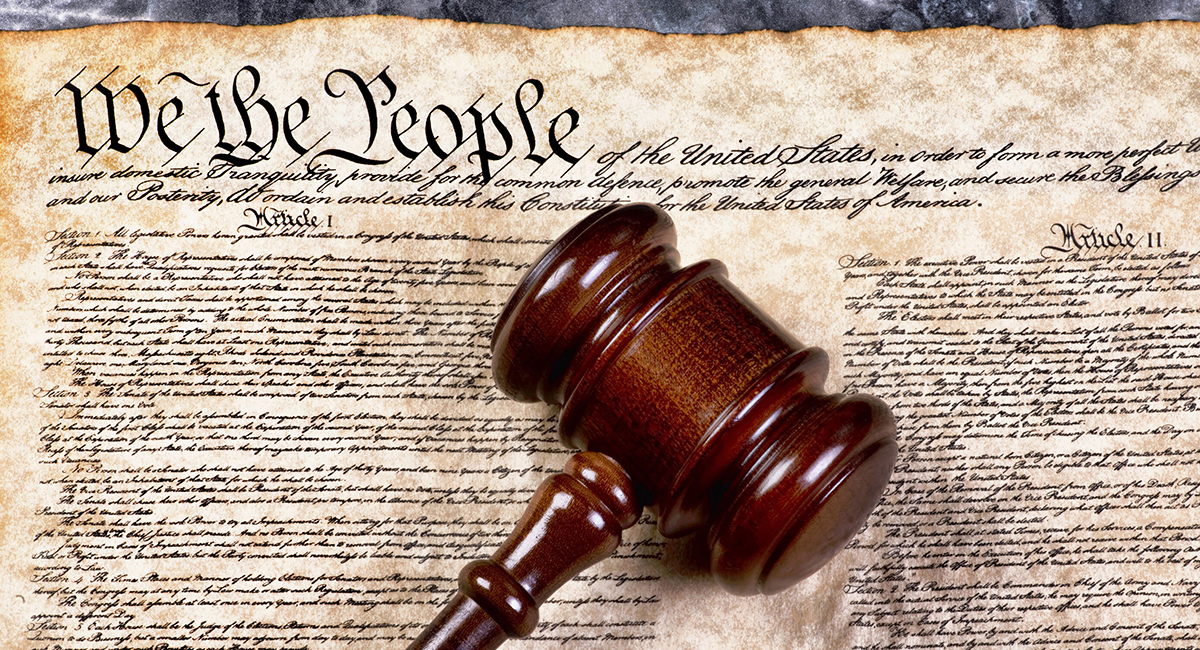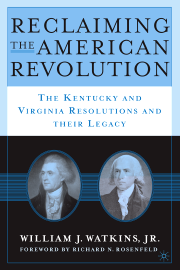Interest in the Ninth Amendment has been renewed with the Supreme Court’s decision in Dobbs v. Jackson Women’s Health Organization (2022), in which the Court held that the Constitution contains no fundamental right to abortion.[1] Many abortion proponents have turned to the Ninth Amendment in criticizing the decision. For example, Damon Root at Reason described the decision as “an [i]nsult to the 9th Amendment” and complained that Dobbs “entirely fails to grapple with this necessary question” of unenumerated rights retained by the people.[2] Writing in the Hartford Courant, Samuel Teixeira suggested that Justice Samuel Alito, the author of the Dobbs opinion, should be impeached for “willingly and knowingly” disregarding the Ninth Amendment.[3]
Root, Teixeira, and others insist that the freedom to end a pregnancy is a right retained by the people under the Ninth Amendment, which provides that “[t]he enumeration in the Constitution, of certain rights, shall not be construed to deny or disparage others retained by the people.” Such arguments ignore the Ninth Amendment’s role as a rule of construction and the fact that it has never been held to apply to the states—even the modern Supreme Court has never incorporated the Ninth Amendment through the Fourteenth Amendment’s Due Process Clause. Consequently, there is simply no basis in history or modern constitutional law to use the Ninth Amendment to strike a state statute.
There are two primary competing interpretations of the Ninth Amendment. The first claims that it serves as a reservoir of fundamental or natural rights that are not specifically mentioned in the Constitution yet nonetheless are entitled to judicial protection.[4] The second claims that it is paired with the Tenth Amendment as a rule of construction to prevent, in the words of constitutional scholar Kurt T. Lash, “any interpretation of enumerated federal power that would allow federal authority to extend into subjects left, as a matter of right, to the sovereign control of the people of the several states.”[5] The latter argument is best supported by the history of the ratification debates and early interpretations by commentators and courts.
Throughout the ratification debates, friends of the Constitution insisted, to quote James Madison in Federalist No. 45, that “[t]he powers delegated by the proposed Constitution to the Federal Government are few and defined. Those which remain in the State Governments are numerous and indefinite.”[6] In the Virginia ratifying convention, Edmund Pendleton assured his colleagues that “[t]he two governments act in different manners, and for different purposes.”[7] The new general government would “operate in great national concerns” and the states “in mere local concerns.”[8] Because the governments existed “for two different purposes” and were both “limited to the different objects, they can no more clash than two parallel lines can meet.”[9] George Nicholas was more direct. In response to arguments that the federal government would possess a general power of legislation, he insisted that federal officials “cannot legislate in any case but those particularly enumerated.”[10] “No gentleman,” Nicholas continued, “who is a friend to the government, ought to withhold his assent from it for this reason.”[11] Governor Edmund Randolph echoed Nicholas’ reasoning. “But in the general Constitution, its powers are enumerated,” Randolph averred. “Is it not, then, fairly deducible, that it has no power but what is expressly given it?—for if its powers were to be general, an enumeration would be needless.”[12]
These grand statements did not satisfy Anti-Federalists. They wanted specific guarantees that (1) the new government’s powers were few and defined, and (2) amendments would be obtained through Article V and not a constitutional interpretation that would extend the powers of Congress to far flung subjects. To address the first issue, the Anti-Federalist writing as the Federal Farmer suggested that the Constitution “declare all powers, rights and privileges, are reserved, which are not explicitly and expressly given up.”[13] A constitutional rule of construction was also needed for the second concern. The Anti-Federalist writer Brutus feared that the courts would interpret the Constitution “not only according to its letter, but according to its spirit and intention; and having this power, they would strongly incline to give it such a construction as to extend the powers of the general government.”[14] In addition to Brutus’ worry about construction, friends of the Constitution in opposing a bill of rights suggested that by specifically stating, for example, that Congress has no power over free speech, would imply that Congress through principles of construction does have power over other rights and privileges not specifically listed.
Based on these concerns, Virginia’s ratifying convention proposed two amendments:
First, That each State in the Union shall respectively retain every power, jurisdiction, and right which is not by this Constitution delegated to the Congress of the United States or to the departments of the Federal Government.
. . . .
Seventeenth, That those clauses which declare that Congress shall not exercise certain powers be not interpreted in any manner whatsoever to extend the powers of Congress. But that they may be construed either as making exceptions to the specified powers where this shall be the case, or otherwise as inserted merely for greater caution.[15]
That those clauses which declare that Congress shall not exercise certain powers be not interpreted in any manner whatsoever to extend the powers of Congress. Other states, including New York, Rhode Island, and North Carolina expressed similar sentiments. These states sought to ensure a system of few and defined federal powers and to guard against the dangers of a constitutional construction that would augment federal power.
In his June 8, 1789 resolution suggesting amendments to the First Congress, James Madison recommended an amendment expressing that powers not delegated to the general government were reserved (our Tenth Amendment) and an amendment aimed at preventing expansive construction that was the forerunner of our Ninth Amendment: “The exceptions here or elsewhere in the constitution, made in favor or particular rights, shall not be so construed as to diminish the just importance of other rights retained by the people; or as to enlarge the powers delegated by the constitution; but either as actual limitations of such powers, or inserted merely for greater caution.”[16]
Madison’s draft version of the Ninth Amendment underwent many changes. Virginia, led by Edmund Randolph, was so unhappy with the result that it contemplated rejecting both the Ninth and Tenth Amendments. Madison assured his friends back home that the final version of the Ninth Amendment accomplished the same thing sought by Virginia’s seventeenth proposed amendment. Randolph admitted that Madison’s interpretation of the Ninth Amendment was “plausible” but he still preferred the original Virginia proposal. Nonetheless, Virginia ultimately ratified both the Ninth and Tenth Amendments.
Madison’s assurance to his friends on the meaning of the Ninth Amendment was genuine. Indeed, when arguing in the House against Hamilton’s plan to create the Bank of the United States, Madison resorted to both the Ninth and Tenth Amendments. The Ninth, Madison contended, “guard[ed] against a latitude of interpretation” and the Tenth “exclud[ed] every source of power not within in the constitution itself.”[17]
Justice Joseph Story interpreted the Ninth Amendment in a similar manner in his dissenting opinion in Houston v. Moore(1820).[18] At issue in Moore was when federal power was exclusive or shared concurrently with the states. Story indicated that unless the Constitution provides that a grant to the federal government is exclusive, then it should be understood that the states have concurrent authority. Story came to this conclusion “not only upon the letter and spirt of the [ninth] amendment of the constitution, but upon the soundest principles of general reasoning.”[19] For Story, the Ninth Amendment was no repository of natural or fundamental rights, but provided a rule of constitutional interpretation. As Lash has observed, “Justice Story interpreted and applied the Ninth Amendment precisely the way James Madison and the state ratifying conventions intended—as a rule of construction preserving the retained right of local self-government.”[20]
Early commentator St. George Tucker in his View of the Constitution of the United States is in accord with Madison and Story. The Ninth Amendment, according to Tucker, was intended “to guard the people against constructive usurpations and encroachment on their rights.”[21] The Ninth and the Tenth together, Tucker taught, require “that the powers delegated to the federal government, are, in all cases, to receive the most strict construction that the instrument will bear, where the rights of a state or of the people, either collectively, or individually, may be drawn into question.”[22] In reviewing Tucker’s words, it is helpful to remember, as pointed out by Raoul Berger, that rights and reserved powers were “two sides of the same coin” for the Founders.[23] We make a mistake if we try to segregate the Ninth Amendment to the realm of individual rights and the Tenth Amendment to the realm of state powers. The Framers, with their emphasis on popular sovereignty and self-government, rejected such a dichotomy.
In modern times, the Ninth Amendment is associated with Griswold v. Connecticut (1965), in which the Supreme Court held that an ancient Connecticut statute banning contraceptives violated a federal constitutional right to privacy found in the penumbras and emanations of the First, Third, Fourth, Fifth, and Ninth Amendments.[24] Justice Arthur Goldberg, joined by Chief Justice Earl Warren and Justice William Brennan, concurred in the opinion, but wrote separately to argue that the right to privacy was embodied in “the language and history of the Ninth Amendment.”[25] Justice Goldberg then set forth the familiar argument that the Ninth Amendment was intended to be a repository of fundamental rights with which government may not infringe. In dissent, Justice Hugo Black challenged Justice Goldberg’s account of the Ninth Amendment and observed that the “Amendment was passed, not to broaden the powers of this Court or any other department of the General Government, but as every student of history knows, to assure the people that the Constitution in all its provisions was intended to limit the Federal Government to the powers granted expressly or by necessary implication.”[26]
In Roe v. Wade (1973), the Supreme Court declined to resort to the Ninth Amendment when finding a constitutional right to abortion. Instead, the Court held that the unenumerated right of privacy was based in the Fourteenth Amendment’s Due Process Clause. This is the same vehicle the Court had used to selectively apply to the states various provisions of the Bill of Rights it deemed as fundamental. The Ninth Amendment has never been applied to the states via selective incorporation. Even jurists such as Hugo Black who argued for total incorporation of the Bill of Rights rather than a picking-and-choosing approach had in mind only the first eight amendments.
Thus, no one can reasonably argue that the Court insulted or violated the Ninth Amendment in Dobbs. Not even the Warren Court went so far as to hold that the Ninth Amendment applied to the states. Moreover, viewing the Ninth Amendment as a rule of construction meant to foil a latitudinarian interpretation of the Constitution shows that it is not a repository of rights simply awaiting Court recognition.
Left-leaning libertarians such as Root find the Court’s Dobbs decision dangerous because it flies against their pet theory of judicial engagement. Rather than the Court sending policy issues such as abortion back to the states, the judicial engagers want a Court that will use all tools available to reach desired outcomes. For example, the Institute for Justice in advocating for judicial engagement states that “[w]hile the powers granted to the federal government by the Constitution are few and limited, the rights guaranteed to individuals are many and broad. The powers of state governments are likewise limited in scope and further constrained by the rights of individuals.” In contending for a national judiciary zealously striking down state laws, the judicial engagers ignore representations discussed above by the friends of the Constitution that state powers were numerous and indefinite. Judges who allow the people of the several states to decide abortion matters through the political process, according to the disciples of judicial engagement, are guilty of “judicial abdication.”
Judicial engagers long for a world in which the Court will appeal to natural rights to constitutionalize certain pet causes such as abortion on demand. The Dobbs majority rejected an invitation to expand Court power; therefore, we have seen renewed claims about the Ninth Amendment and the dynamism it promises. It is the same power coveted by Justices Goldberg, Warren, and Brennan in their Griswold concurrence. We can also rest assured that judicial engagement will be used in a manner consistent with the jurisprudence of Justices Goldberg, Warren, and Brennan.
**************
[1] 2022 WL 2276808 (June 24, 2022).
[2] Damon Root, “Alito’s Abortion Ruling Overturning Roe Is an Insult to the 9th Amendment,” Reason (6/24/2022).
[3] Samuel Teixeira, Alito’s abortion ruling violates the Ninth Amendment, Hartford Courant, (July 4. 2022).
[4] See, e.g., Randy E. Barnett, The Ninth Amendment: It Means What It Says, 85 Tex. L. Rev. 1 (2006).
[5] Kurt T. Lash, The Lost Jurisprudence of the Ninth Amendment, 83 Tex. L. Rev. 597, 604 (2005).
[6] Federalist No. 45, p. 236 (James Madison) (Bantam Books, ed., 1982).
[7] Elliot’s Debates 3:301.
[8] Id.
[9] Id.
[10] Id. at 451.
[11] Id.
[12] Id. at 464.
[13] Federal Farmer , Letter XVI (1788), reprinted in TAF:281.
[14] Brutus, Essay XII (1788), reprinted in TAF:455.
[15] Veit at 19 & 21.
[16] Id. at 12 & 14.
[17] James Madison’s Speech on the Bank Bill (1791), reprinted in Liberty & Order at 77.
[18]18 U.S. 1 (1820).
[19] Id. at 49 (Story, J., dissenting).
[20] Kurt T. Lash, The Lost Jurisprudence of the Ninth Amendment, 83 Tex. L. Rev. 597, 597 (2005).
[21] SGT View at 105.
[22] Id.
[23] Raoul Berger, The Ninth Amendment, 66 Cornell L. Rev. 1, 3 (1980).
[24] 381 U.S. 479, 484 (1965)
[25] Id. at 487 (Goldberg, J., concurring).
[26] Id. at 520 (Black, J., dissenting).












